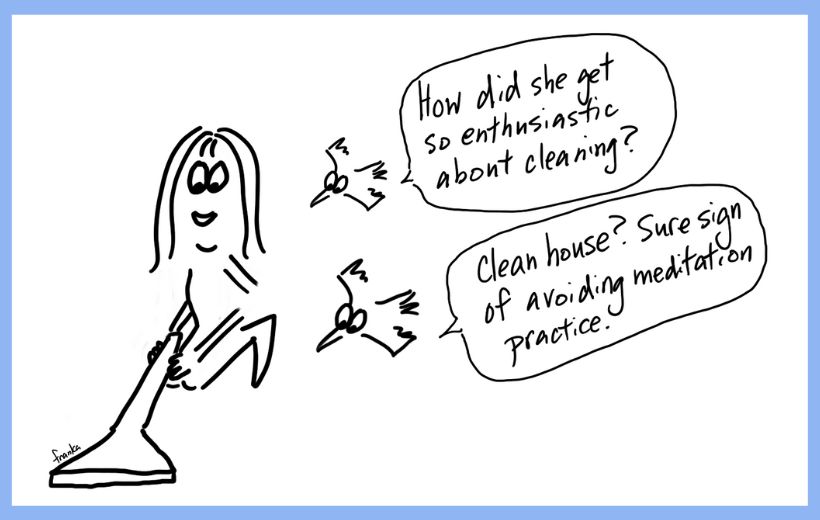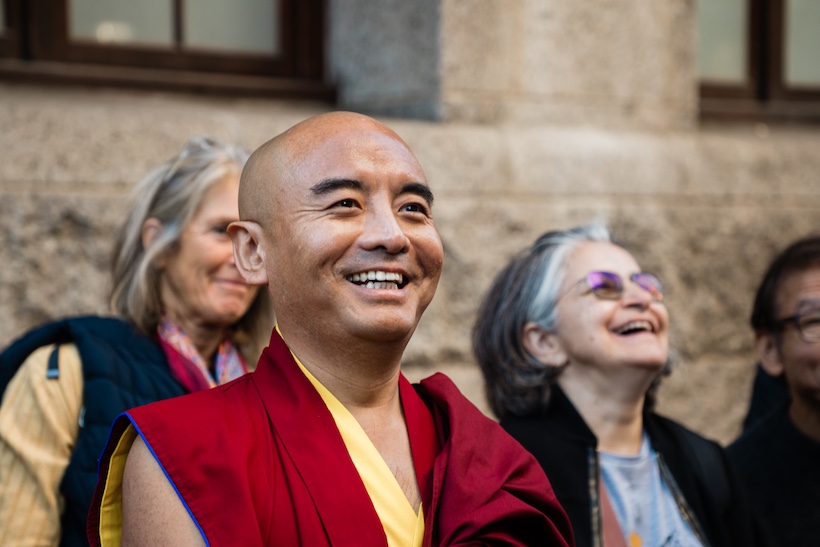Resistance: The Long Way to the Cushion
By Franka Cordua-von Specht • 3 min read
By Franka Cordua-von Specht • 3 min read

OH MY, THE RESISTANCE TO ON-THE-CUSHION MEDITATION! One particular day comes to mind, still fresh and vivid.
My 98-year-old aunt had passed away peacefully days earlier, and I wanted to spend the day thinking about her and meditating on my cushion. I had bought fresh flowers the day before and arranged them beside her photo. I was ready to light the candle… but wait. I noticed how dusty the surface was where the flowers and picture stood. I proceeded to find my dust cloth and carefully dusted all the special items, including little statues and other sacred items. I spent some time moving around the different items. Now I was ready! I sat on my meditation cushion and — wait — I noticed the layer of dust covering the floor. Quickly, the vacuum came out.
Tergar Instructor Tim Olmsted once said something that echoed in my mind: The more clearly we know why we meditate, the more likely we are to actually make our way to the cushion… The words came and went through my mind, but a pressing question emerged. Should I mop beyond my meditation space? Of course! I proceeded to vacuum and mop my apartment.
I was surprised by the rush of energy, as I’m generally not known to be a meticulous duster or mopper (despite owning a dog who sheds massively).
With the floors now clean, I noticed a bookshelf that I had wished to place in a different corner of the room.
While moving the bookshelf, more of Tim’s words came back. He often emphasizes our intention to meditate, and he says that what we place higher on the bookshelf — both literally and figuratively — reveals what we value most. A twinge of guilt.
But I immediately found my rationale. I decided that the time investment in cleaning was important in order to create an “uplifted” meditation space. Those are the words that I’d heard long ago from my first meditation teacher: “You want to want to go to your cushion.” That gave me permission to rehang a photo, fold the laundry — the list went on.
Of course, I realized I was resisting meditation. You see, my on-the-cushion meditation habit had been somewhat interrupted by … I could name a long list here… work, travel, and — most of all — having a roommate. Ah, yes, I could point to different factors.
Why was my meditation practice so susceptible to these external influences? In fact, I realized my meditation habit was still vulnerable at its core. It wasn’t able to accommodate the joy and busyness of a roommate or a change in routine. And I didn’t do well when I didn’t have a dedicated meditation space.
These reflections reminded me of an interview in which Tergar CEO and Instructor Cortland Dahl spoke with Thupten Jinpa, the long-time assistant to the Dalai Lama. Thupten Jinpa shared that when he and his wife moved to Montreal with their one-year-old daughter, they made a conscious decision to place the television in the basement. It would be too easy to turn on the television if it were right there! “When you watch something, it has to be more deliberate.”
At this point, Cortland chimed in: “You construct your environment to support the habit that you want to build or avoid a habit you don’t want to build.” Scientifically this is called an “affordance,” said Dr. Richard Davidson in a recent Dharma Lab podcast, providing the following easy-to-understand example: the presence of a water fountain in a room will automatically encourage those nearby to drink water.
Their words have stayed with me. Now, I should mention that my meditation space is no longer my bedroom, and I have re-bonded with my cushion.
As I contemplated these insights, I felt a stir in my belly. Breakfast! Off the cushion to the kitchen?
How easy it is to be pulled away! There is always something that is tugging at us that seems more pressing than practice.
We can simply notice this penchant for distraction, with awareness, as Mingyur Rinpoche teaches. That can give us the space and time to consider the intention and decide how high the thing that we are doing is on our Bookshelf.
With clarity of intention, and settled into an uplifted (and dust-free) space, I did manage to sit on my cushion for some hours of formal meditation and think about my dear aunt, who lived a long and beautiful life.
December 2025


Franka Cordua-von Specht, co-founder of the Tergar Vancouver Practice Group and Tergar Canada, contracts for Tergar International’s marketing and communication team. She is a Tergar Guide and facilitates Joy of Living workshops.
Learn meditation under the skillful guidance of world-renowned teacher Yongey Mingyur Rinpoche at your own pace.


Mingyur Rinpoche’s 2025 visit to South Africa brought together decades of Buddhist practice and fresh inspiration for a growing meditation community.

“…the source of the distress is coming from your own mind. You’re the one beating yourself over the head. The good news is, this means you also have the power to stop!”

“The practice of meditation allows us to relax this misguided search for happiness in the objects of experience. It allows us to settle and connect with the unchanging peace, the natural wellbeing that is the very nature of mind itself.” – Tim Olmsted
If you enjoyed reading our articles, please join our mailing list and we’ll send you our news and latest pieces.